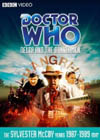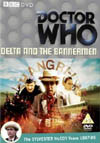DVD Extras include:
Though this is primarily an Earth-bound story (and is, in fact, the ONLY time Melanie appears on Earth with the Doctor), it nicely includes bits on alien planets and a galactic tollport that we assume to be part of some kind of space station. The TARDIS gets some good action in this opener, even if interior scenes are a bit skimped on due to production oddities.
Vacation Flight of the ChimeronThe title of the story apparently went back and forth between "Delta and the Bannermen" and "Flight of the Chimeron" several times, and I have to say I think they ultimately chose the less exciting of the two possibilities. "Flight of the Chimeron" sounds cool and quite intriguing, and would also work well with the alternate story direction I had been hoping for. "Delta and the Bannermen" doesn't sound right as a story title, and perhaps emphasizes elements of the story that shouldn't have been focused on quite as much.A lot of good elements combine to make Part One the success that it is. The opening travel scenes provide a great backbone for the story's action and its humour, while properly showcasing Doctor Who's interstellar scope and offering many opportunities for eye-candy effects. Although a lot of the effects are done well and satisfy, we once more have to put up with a lack of stars behind the trajectory of any moving objects in space, a repeat of a problem from "Time and the Rani" (story no. 148). Of course, proper laser beams would add another level of excitement to the shootouts, even if the spark charges already have a good energy and are well-directed as is. There's also a misleading edit early on, with Melanie just outside the TARDIS begging the Doctor to agree to go to Earth, and then cutting to a shot of a police box in a grassy field, which Weismuller and Hawk will soon approach. It gives the impression that the Doctor and Melanie have already come to Earth, and we missed it, and there will be humour afoot as the two American characters mistake the time/space machine for a regular phone box. But this time, the joke's on the viewer, and it doesn't seem like the production team intended it. This police box is actually just supposed to be a police box. Ideally, Weismuller and Hawk should find a regular phone booth to make their calls from, and I can only imagine the production team thought they could save themselves from having to build a period prop by having their TARDIS prop do double duty. Arrgh. Even in 1959, a police box looks too incongruous in the middle of a grassy country clearing. But these minor glitches are quite minor considering Part One's offerings. Two more threads dominate here and appear to be steering the adventure towards classic status. Firstly, the story looks like it's setting itself up to be a grand parody of just how bizarre things can be when one goes off on holiday, and what a wide variety of strange people one can encounter. Although it all began with the initial travel to one's destination, it looks all set to continue through the stay and include the return journey. The Chimeron Queen Delta and Gavrok's Bannermen pursuing her are an exciting, action-providing part of a greater web of interesting struggles and character types. Secondly, we get the archetypal challenge of a love triangle, with a lot of focus going to Sara Griffith's endearing and sympathetic portrayal of Ray on the unrequited end of it. Additionally, we see our main character the Doctor spending a lot of time empathizing with her, making one wonder if he isn't going to make helping her out one of his main aims in this story. By contrast, the other two participants in the triangle, Billy and Delta, are considerably bland in portraying any emotional chemistry towards each other. Thus, the audience easily invests in Ray's struggle, and anticipation is built to see it through to success at the end. In fact, all this is pretty much on par with a successful ensemble romantic comedy, mirroring the kind of character arcs found in movies like "Carry On Abroad" or "Carry On Cruising", while Doctor Who's sci-fi elements can allow the bizarreness to reach more exaggerated extremes. The fun continues with ear-candy, as a lot of period rock and roll songs are showcased during Part One's enjoyable dance sequences. Topping off Part One is a double cliffhanger abounding in threats and unanswered questions. Fantastic!
We also seem to be ending up with a lot of short scene snippets with characters talking to each other, yet being unable to get to the point and communicate. Weismuller and Hawk's first encounter with the Bannermen is a prime example. The characters wind up running around a lot in these later two episodes, often covering the same ground twice, and it's easy to lose track of what they're aiming to accomplish much of the time. We learn a lot about Delta's species in these later two episodes, which is generally good sci-fi exploration. It's done in a very unusual way this time though, with an almost Japanese subtlety of inferring ideas that are not explicitly said, which has merit. But this time around, it seems to require a lot of extra characters to get the point across, and isn't involving the Doctor and his companion as much as would be ideal.
The story keeps the Doctor in the proper hero mode for its final moves, also managing to use the action to help illustrate one of the points it brought up earlier. Not bad at all. Is this a better story than "Time and the Rani"? It certainly contains a higher percentage of quality scenes, and can undoubtedly make more enjoyable viewing and listening. But when all is said and done, it is less memorable and has been less of an event in the Whoniverse. Much of this stems from the style and scope of each story's main villain and the plots that they each hatch, while also considering the strength and timing of their best confrontations with the Doctor. "Time and the Rani" still ends up with a stronger "main event" at its climax, plus the additional event of the change of Doctor earlier in the story, which allows it to continue to inch ahead in my rankings. If only "Delta and the Bannermen" had continued to satisfy with the more interesting threads showcased in its first episode, the ranking might be very different.
This story is available on DVD and VHS video. Click on the Amazon symbol for the location nearest you for pricing and availability:
Comments on this article are welcome. You may contact the author from this page:
|









